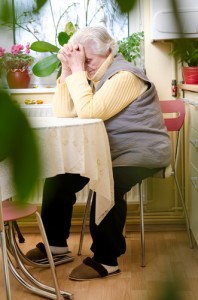
There are around 60,000 out-of-hospital cardiac arrests in the UK every year. Some of these events occur in the presence of relatives who may witness the cardiopulmonary resuscitation (CPR) by the resuscitation team (you can find out more about CPR at the Resuscitation Council’s website).
The emotional consequences of this for the relatives and the resuscitation staff has been the subject of much debate. It is thought to be helpful for relatives in coming to terms with the situation, saying goodbye and knowing that everything was done that could have been. However, the evidence for this is limited to small, low-level studies.
A research group from France designed a prospective multi-centre randomised controlled trial of family presence during resuscitation to test this idea in their study of ‘Family presence during cardiopulmonary resuscitation’.
Methods
15 ambulance base stations or mobile intensive care units consisting of an ambulance driver, a nurse and a senior emergency doctor participated in the study. 8 of these units were randomly assigned to the intervention, which was the invitation to observe the CPR. The intervention units used a communication guide to ensure that the invitation to observe was consistent. In the control group of 7 units, family members were not routinely invited to observe the CPR; instead, the doctor interacted with these relatives in a standard manner during the CPR. In this group, relatives could request to observe the CPR even though they were not they invited. Family member participants were the closest adult relative of the adult patient in cardiac arrest occurring at home.
Relatives were followed-up by telephone 90 days after the CPR by a trained psychologist who was unaware of which group the relative had been assigned to. Participants were interviewed and completed the Impact of Event Scale (IES) to measure symptoms of Post Traumatic Stress Disorder (PTSD) and the Hospital Anxiety and Depression Scale (HADS).
Outcomes of interest were the:
- Proportion of relatives with PTSD-like symptoms (a score of > 30/75 on the IES),
- Presence of anxiety or depression,
- Effect of family presence on medical efforts at CPR,
- Well-being of the health care team, and
- Occurrence of medico legal claims.
Results
At baseline
- 570 relatives were enrolled in the study (266 intervention vs 304 controls)
- Over 70% of the participants in each group witnessed the arrest
- Although not invited, 43% of the control group observed the CPR
- Significantly more participants in the control group were unable to complete the IES due to emotional consequences of the event (p=0.007)
At follow-up

The frequency of PTSD-like symptoms was significantly higher among relatives who were not invited to observe and those who did not observe the CPR.
- The frequency of symptoms of anxiety and depression symptoms was significantly higher among relatives who did not witness resuscitation than among those who did (P<0.001 for anxiety and P=0.009 for depression)
- 12% or relatives who did not observe the CPR expressed regret at being absent, compared with 3% of who observed the CPR who regretted being present (P<0.001)
- Less than 1% of relatives were aggressive or in conflict with the resuscitation team
- There was no significant difference in stress levels among staff according to family-presence status
- There were no medico-legal claims (and one thank you letter from an intervention participant!)
Discussion
The authors concluded:
Irrespective of whether the family members were offered the choice, more favourable results of psychological testing were noted when family members were present.
This study is the first relatively large, well powered study that tested the idea that observing the CPR of a relative can reduce the chance of later psychological problems for family members. It used intention to treat analysis (accounting for those who could not participate in the follow-up interview) to reduce bias and they analysed data based on invitation to observe, and observation separately.
They collected a large amount of interesting data such as the cause of arrest, the relationship of the relative to the patient, and characteristics of the arrest. However, they only mentioned that they took into account the relationship of the relative to the patient in their analysis. Some of those other factors should have been examined as they might have affected the results.

Anyone who has strong feelings against having CPR may want to consider writing a living will otherwise known as an advanced decision.
The medical profession is often criticised for being paternalistic. The idea behind this from a medical perspective is that in excluding the relatives from a potentially distressing situation, they are protecting them from the emotional consequences of this event. This study provides evidence that inclusion could be protective, and therefore observation should be offered.
Although this intervention appears to have been helpful for relatives, we must not forget the patients’ rights. In this study (for obvious reasons) the patient was not able to consent to the intervention or the CPR. It was interesting to learn from this study that only 4% of people receiving CPR were alive at day 28.
Anyone who has strong feelings against having CPR may want to consider writing a living will otherwise known as an advanced decision. Clinicians should raise this with their patients who have severe long-term illnesses. It is an important way of stating your preferences in advance of a situation where you cannot make that decision for yourself (find out more about advanced decisions here).
Links
Jabre P. et al Family Presence during Cardiopulmonary Resuscitation. New England Journal of Medicine 2013;368:1008-18.


Seeing is believing; how does family presence during cardiopulmonary resuscitation affect psychological outcom… http://t.co/fvXIo1UZpb
@ag2460 blogs about a @NEJM study on family presence during cardiopulmonary resuscitation http://t.co/juBLVtqjFa #PTSD #trauma
@ag2460 highlights the importance of advanced decisions or living wills http://t.co/juBLVtqjFa
how does seeing CPR affect psychological outcomes for family members? http://t.co/9ya1nZFif4 via @sharethis
Don’t miss: How does family presence during cardiopulmonary resuscitation affect psychological outcomes for family? http://t.co/ms3non7oGX
Mental Elf: Seeing is believing; how does family presence during cardiopulmonary resuscitation affect… http://t.co/UDMi0KkpFs